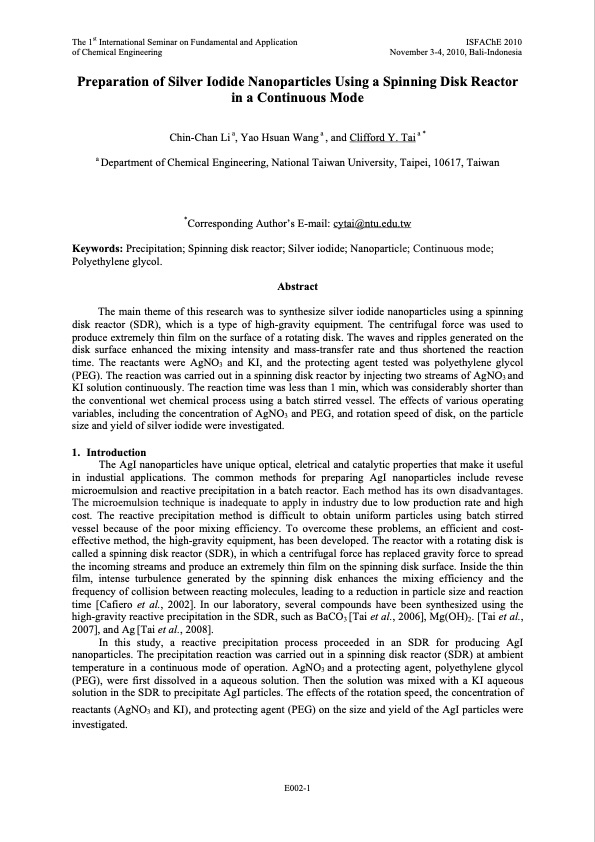
PDF Publication Title:
Text from PDF Page: 001
The 1st International Seminar on Fundamental and Application ISFAChE 2010 of Chemical Engineering November 3-4, 2010, Bali-Indonesia Preparation of Silver Iodide Nanoparticles Using a Spinning Disk Reactor in a Continuous Mode Chin-Chan Li a, Yao Hsuan Wang a , and Clifford Y. Tai a * a Department of Chemical Engineering, National Taiwan University, Taipei, 10617, Taiwan *Corresponding Author’s E-mail: cytai@ntu.edu.tw Keywords: Precipitation; Spinning disk reactor; Silver iodide; Nanoparticle; Continuous mode; Polyethylene glycol. Abstract The main theme of this research was to synthesize silver iodide nanoparticles using a spinning disk reactor (SDR), which is a type of high-gravity equipment. The centrifugal force was used to produce extremely thin film on the surface of a rotating disk. The waves and ripples generated on the disk surface enhanced the mixing intensity and mass-transfer rate and thus shortened the reaction time. The reactants were AgNO3 and KI, and the protecting agent tested was polyethylene glycol (PEG). The reaction was carried out in a spinning disk reactor by injecting two streams of AgNO3 and KI solution continuously. The reaction time was less than 1 min, which was considerably shorter than the conventional wet chemical process using a batch stirred vessel. The effects of various operating variables, including the concentration of AgNO3 and PEG, and rotation speed of disk, on the particle size and yield of silver iodide were investigated. 1. Introduction The AgI nanoparticles have unique optical, eletrical and catalytic properties that make it useful in industial applications. The common methods for preparing AgI nanoparticles include revese microemulsion and reactive precipitation in a batch reactor. Each method has its own disadvantages. The microemulsion technique is inadequate to apply in industry due to low production rate and high cost. The reactive precipitation method is difficult to obtain uniform particles using batch stirred vessel because of the poor mixing efficiency. To overcome these problems, an efficient and cost- effective method, the high-gravity equipment, has been developed. The reactor with a rotating disk is called a spinning disk reactor (SDR), in which a centrifugal force has replaced gravity force to spread the incoming streams and produce an extremely thin film on the spinning disk surface. Inside the thin film, intense turbulence generated by the spinning disk enhances the mixing efficiency and the frequency of collision between reacting molecules, leading to a reduction in particle size and reaction time [Cafiero et al., 2002]. In our laboratory, several compounds have been synthesized using the high-gravity reactive precipitation in the SDR, such as BaCO3 [Tai et al., 2006], Mg(OH)2. [Tai et al., 2007], and Ag [Tai et al., 2008]. In this study, a reactive precipitation process proceeded in an SDR for producing AgI nanoparticles. The precipitation reaction was carried out in a spinning disk reactor (SDR) at ambient temperature in a continuous mode of operation. AgNO3 and a protecting agent, polyethylene glycol (PEG), were first dissolved in a aqueous solution. Then the solution was mixed with a KI aqueous solution in the SDR to precipitate AgI particles. The effects of the rotation speed, the concentration of reactants (AgNO3 and KI), and protecting agent (PEG) on the size and yield of the AgI particles were investigated. E002-1PDF Image | Silver Iodide Nanoparticles Using a Spinning Disk Reactor

PDF Search Title:
Silver Iodide Nanoparticles Using a Spinning Disk ReactorOriginal File Name Searched:
preparation-of-silver-iodide-nanoparticles-spinning-disk-reactor.pdfDIY PDF Search: Google It | Yahoo | Bing
Turbine and System Plans CAD CAM: Special for this month, any plans are $10,000 for complete Cad/Cam blueprints. License is for one build. Try before you buy a production license. More Info
Waste Heat Power Technology: Organic Rankine Cycle uses waste heat to make electricity, shaft horsepower and cooling. More Info
All Turbine and System Products: Infinity Turbine ORD systems, turbine generator sets, build plans and more to use your waste heat from 30C to 100C. More Info
CO2 Phase Change Demonstrator: CO2 goes supercritical at 30 C. This is a experimental platform which you can use to demonstrate phase change with low heat. Includes integration area for small CO2 turbine, static generator, and more. This can also be used for a GTL Gas to Liquids experimental platform. More Info
Introducing the Infinity Turbine Products Infinity Turbine develops and builds systems for making power from waste heat. It also is working on innovative strategies for storing, making, and deploying energy. More Info
Need Strategy? Use our Consulting and analyst services Infinity Turbine LLC is pleased to announce its consulting and analyst services. We have worked in the renewable energy industry as a researcher, developing sales and markets, along with may inventions and innovations. More Info
Made in USA with Global Energy Millennial Web Engine These pages were made with the Global Energy Web PDF Engine using Filemaker (Claris) software.
Infinity Turbine Developing Spinning Disc Reactor SDR or Spinning Disc Reactors reduce processing time for liquid production of Silver Nanoparticles.
| CONTACT TEL: 608-238-6001 Email: greg@infinityturbine.com | RSS | AMP |